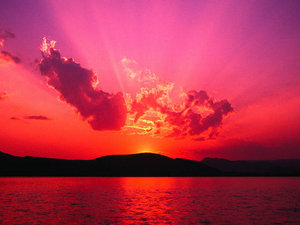Sunset
|
|
Sunset, also called sundown in some American English dialects, is the time at which the Sun disappears below the horizon in the west. It should not be confused with dusk, which is the (variously defined) point at which darkness falls, some time after the Sun itself sets (which begins twilight).
The red hues of the sky at sunset are caused by the Rayleigh scattering of blue light by atmospheric dust. Relatively little red light is scattered in this way, and so the sky often takes on shades of red, orange and yellow. The color of a sunset may be enhanced by atmospheric phenomena such as clouds, smoke and smog produced by natural processes or human activity, and by ash from volcanic eruptions. A number of eruptions in recent times, such as those of Mount Pinatubo in 1991 and Krakatoa in 1883, have been sufficiently large to produce remarkable sunsets (and sunrises) all over the world.
Nightfall_europe-and-afrika_20050507-184500.jpg
The sunset is often more brightly coloured than the sunrise. The atmosphere responds in a number of ways to exposure to the Sun during daylight hours. In particular, there tends to be more dust in the lower atmosphere at the end of the day than at the beginning. During the day, the Sun heats the surface of the Earth, lowering the relative humidity and increasing wind speed and turbulence, which serves to lift dust into the air. However, differences between sunrise and sunset may in some cases depend more on the geographical particulars of the location from which they are viewed. For example, on an west-facing coastline, sunset occurs over water while sunrise occurs over land.
The timing of sunset varies with the time of year and the latitude of the location from which it is viewed (and, in local time, with the location's precise longitude). Changes in timing of sunset are driven by the axial tilt of Earth and the planet's movement around its orbit, however in the Northern Hemisphere (for example), the earliest sunset is not at the winter solstice around December 21, but rather in early December. Likewise, the latest sunset is not around June 21 (the summer solstice), but in early July. (The dates may be swapped for sunset timings in the Southern Hemisphere.) For one or two weeks surrounding both solstices, both sunrise and sunset get slightly later each day. Even on the equator, sunrise and sunset shift several minutes back and forth through the year, along with solar noon. This effect is plotted by an analemma.
As sunrise and sunset are calculated from the leading and trailing edges of the Sun, and not the center; this slightly increases the duration of "day" relative to "night". Further, because the light from the Sun is bent by the variable density of the Earth's atmosphere, the Sun is still seen after it is below the horizon. This effect is a daily illusion along with sunrise.
As a visual motif, sunset is often associated with summer, and (particularly when paired with a coconut palm) beach living and surfing culture. This may be due in the first instance to people spending more time outdoors in the evening during summer than during winter, and also because pictures of sunsets over the sea are often more spectacular than daytime beach scenes (see images below).
Sunset is also a symbol of ending, closure and old age.
Other meanings
- The Sunset is also an common abbreviation for the name of the Sunset District of San Francisco, California, USA. See: Sunset District (San Francisco)
- To sunset a legislative measure is to include in it a sunset provision.
- Sunset is the name of a famous street (Sunset Boulevard) in Los Angeles, California.
- Sunset is the title of a magazine published in the United States.
External link
Sunrise and sunset calculator (http://www.sunrisesunset.com/)
More images
de:Sonnenuntergang es:Ocaso pl:Zachód (czas) nl:Zonsondergang



